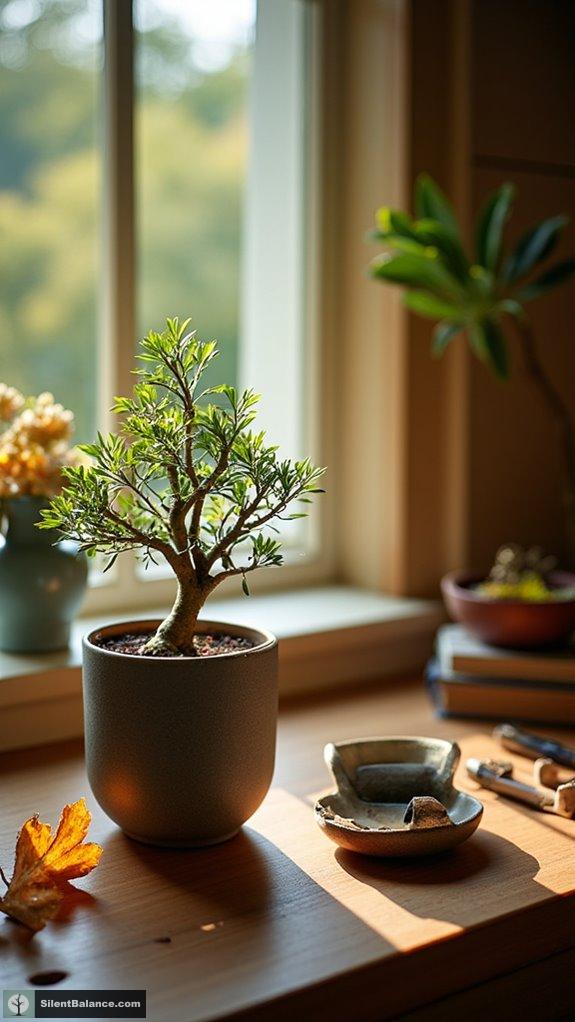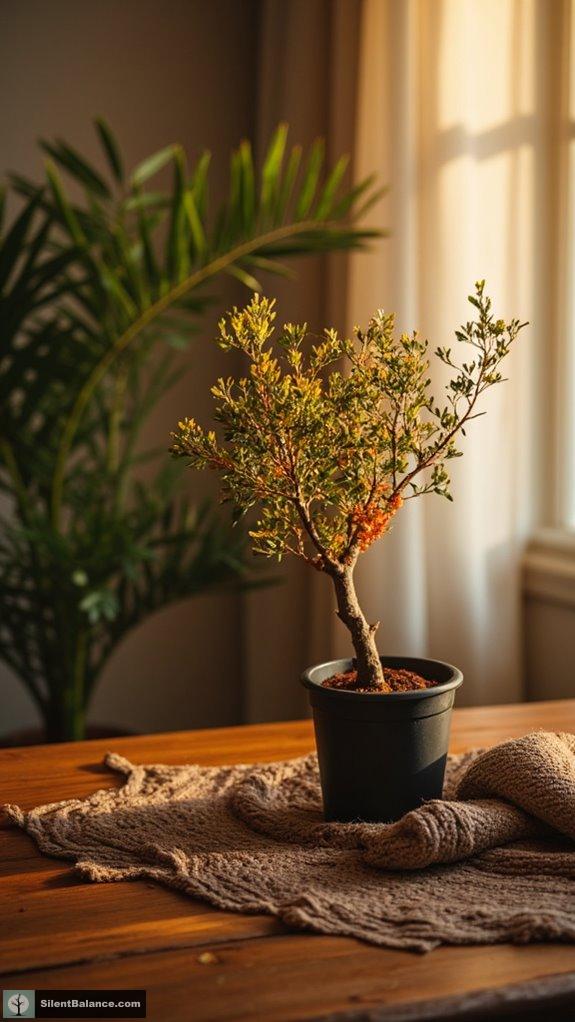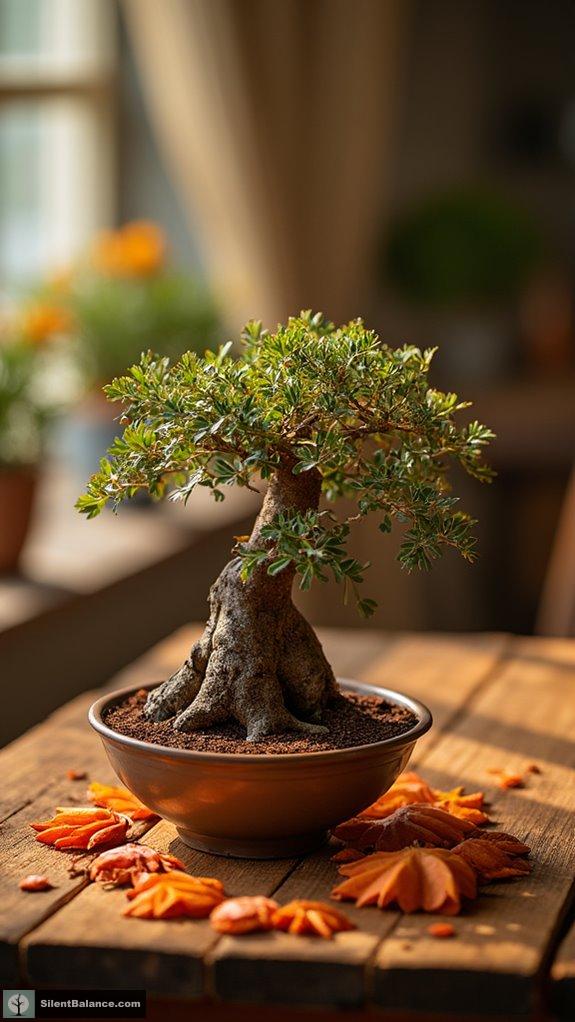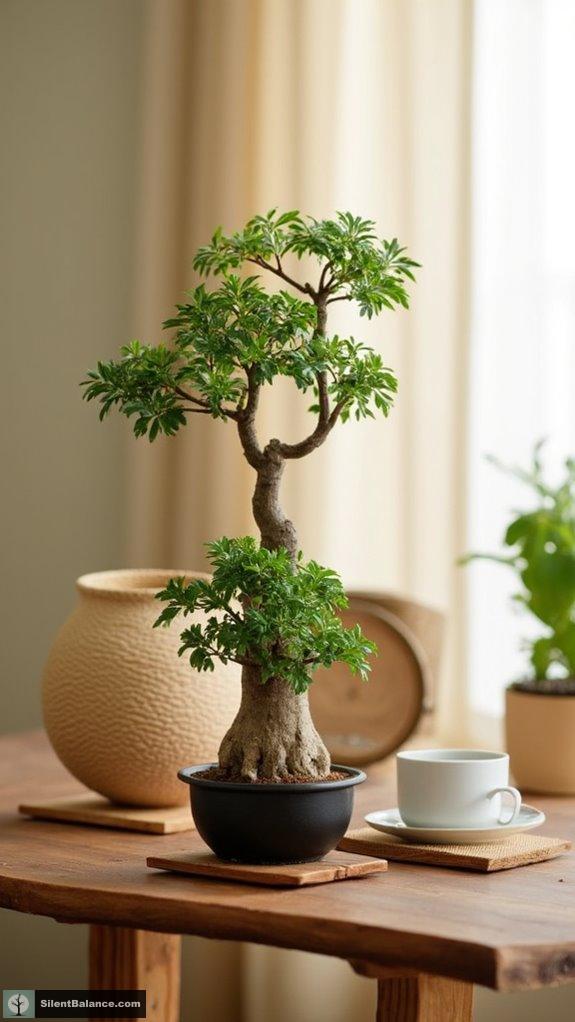As I nurture my bonsai this autumn, I can’t help but embrace the wisdom of the season. Leaf shedding? It’s all about letting go, right? Pruning at the right time keeps our tiny trees thriving. Patience is key during this colorful change, making each moment count. Plus, decay enriches the soil for future growth—who would’ve thought? Balancing aesthetics and health is a dance, and hey, there’s more to learn from these graceful trees! Let’s explore together!
Quick Takeaways
- Embrace the impermanence of life, as seen in leaf shedding, to cultivate personal growth and adaptation.
- Engage mindfully in pruning; careful cuts support healing and maintain the tree’s energy balance.
- Practice patience in autumn, observing nature’s rhythms to provide appropriate care for your bonsai.
- Reflect on decay’s role in renewal, recognizing how fallen leaves enrich soil and foster future growth.
- Adjust your watering routine thoughtfully, as autumn temperatures shift, to protect your bonsai’s roots and overall health.
Embracing Impermanence Through Leaf Shedding

As the temperatures drop and the days shorten, I find myself reflecting on the beauty of change, particularly in our bonsai friends who embrace the art of impermanence through leaf shedding.
Just think about it! Those maple leaves, fierce in their vibrant hues, relinquish their grip as hormones dance in harmony, governing their graceful exit.
It’s nature’s way of saying, “Hey, let’s conserve energy for winter!” This process is essential, as inadequate light can lead to leaf drop during the colder months.
Embracing this cycle, we learn that impermanence isn’t a loss but a powerful reminder of our own resilience.
So, as your bonsai sheds, consider what you might let go in your life.
Ready to embrace change?
The Art of Letting Go: Pruning as a Practice

The art of letting go embodies a profound wisdom that resonates deeply with bonsai practitioners.
It’s not just pruning; it’s a powerful ritual of transformation.
Consider these principles:
- Timing is key: prune when leaves fall, but not too soon!
- Use concave cutters—hello, less scarring!
- Remove excess growth to balance energy—don’t hoard it!
- Embrace this mindful practice of decay and renewal—life’s a cycle.
- Seal those cuts to promote healing, or risk inviting infection!
Cultivating Patience in Autumn Care

When you plunge into the world of bonsai during autumn, you quickly grasp that cultivating patience isn’t just a virtue—it’s a necessity.
Embrace the journey of bonsai this autumn—patience is your greatest ally in this delicate art.
The beauty of deciduous trees preparing for dormancy demands our keen observation. Do you really want to risk sap bleeding by pruning at the wrong time?
Instead, embrace the slow, deliberate art of monitoring moisture.
Feel that soil—dry? Water thoughtfully, but don’t drown your roots in love!
Symbolism of Decay and Renewal in Bonsai

Every autumn, while I’m observing the slow dance of leaves transforming into vibrant shades of red and gold, I can’t help but reflect on the powerful symbolism of decay and renewal that bonsai embodies.
- Fallen leaves remind us of the impermanence of life.
- The abscission process teaches us the importance of letting go.
- Decay nurtures the groundwork for future growth.
- Like Buddhism, bonsai captures life’s fleeting beauty.
- Aging bonsai prompts contemplation of dignity in decline.
This dynamic tension between decay and renewal offers us profound understanding, revealing that with endings come new beginnings and untapped potential.
What’re you ready to renew?
Reflecting on Nature’s Rhythms and Cycles

As the vibrant hues of autumn breeze through my bonsai collection, I’ve often marveled at how these miniature trees echo the rhythms and cycles of nature around us. Each leaf that falls reminds me of life’s inherent impermanence—so powerful and raw.
| Nature’s Cycle | Bonsai Reflection | Spiritual Understanding |
|---|---|---|
| Autumn’s decay | Leaf shedding | Embrace change |
| Dormancy phase | Inward focus | Prepare for growth |
| Harvesting | Visible transformation | Reap rewards |
| Energy shifts | Seasonal care | Cultivate patience |
| Renewal | New buds | Hope for rebirth |
Aren’t these cycles just incredible?
They teach us resilience, prompting thoughtfulness during life’s inevitable changes.
Finding Balance in Tree Health and Aesthetics

Nature’s vibrant change in autumn isn’t just a backdrop for our bonsai—it shapes how we think about the trees we care for. Finding balance in tree health and aesthetics is essential for a thriving bonsai.
Here’s what I focus on:
- Prune deciduous trees when they’re flaunting their full autumn colors.
- Adjust watering to prevent root rot as temperatures dip.
- Protect sensitive species from harsh frosts while maximizing sun exposure.
- Engage in light pruning and wire training for structure.
- Minimize foliage cutting to maintain energy reserves.
With care, we guarantee our bonsai flourish through winter’s grasp!
Mindfulness in Seasonal Transition and Maintenance

Autumn’s embrace and the gentle shift in seasons bring a revitalizing viewpoint to our bonsai practice, don’t they? While I revel in the vibrant colors around me, I stay alert to my bonsai’s needs.
| Task | Timing | Considerations |
|---|---|---|
| Fertilization | Until late October | Use low-nitrogen for winter prep |
| Pruning | Late October to early Nov. | Balance energy for future growth |
| Watering | Adjust with temperature | Prevent overwatering, especially for junipers |
| Observation | Regularly check | Adapt care to seasonal shifts |
| Energy Management | Limit heavy pruning | Avoid forcing late growth |
This mindful approach aligns my practice with nature’s rhythm.
Tiny Tree, Big Lessons

In my journey with bonsai, I’ve found that these tiny trees often offer lessons that feel monumental, as if they hold wisdom far beyond their size.
Just think about what they teach us:
- Patience—cultivating a bonsai isn’t a sprint; it’s a marathon.
- Resilience—setbacks are part of growth; embrace them to evolve.
- Mindfulness—each snip and care encourages presence in the moment.
- Interdependence—the tree thrives with your attention, teaching us about connection.
- Impermanence—life changes, so let’s learn to adapt gracefully.
Additionally, Buddhist symbolism in bonsai practices reminds us that these trees serve as reflections of our inner journey.
Isn’t it fascinating how a tiny tree can inspire such profound reflections?
Questions and Answers
What Tools Are Essential for Autumn Bonsai Care?
Caring for bonsai in autumn is like orchestrating a symphony—each tool plays its crucial role.
You’ll need bonsai scissors for those precise trims, pruning shears for thicker branches, and concave cutters to minimize scars.
Don’t forget wire cutters and branch cutters, as they’re essential for shaping!
With root hooks and a trusty grafting knife, you’ll navigate repotting like a pro.
Ready to elevate your bonsai game? Let’s dig in!
How Can I Prevent Pests in My Bonsai During Autumn?
To prevent pests in my bonsai this autumn, I keep an eagle eye on them.
I inspect weekly, tapping branches to catch sneaky red spider mites.
If I see trouble, I’m quick to shield my little trees with a soap wash or a strong water blast—think of it as a spa day for them!
Plus, I’m cautious about treatments; after all, we want our bonsai thriving, not stressed, right?
How do you protect your green kin?
What Signs Indicate My Bonsai Is Healthy in Autumn?
Did you know that a well-cared-for bonsai can live for over a century?
In autumn, look for your bonsai’s foliage showing vibrant color changes, and you’ll know it’s thriving.
Are the leaves gradually dropping, or is there new growth emerging?
These signs hint at its vigor.
If those needles on your conifers are yellowing, check their age; it’s natural.
A healthy bonsai sings a beautiful symphony of conditions, so embrace the art!
When Should I Stop Watering My Bonsai in Fall?
When should I stop watering my bonsai in fall?
Well, I usually tune in to the vibes of my bonsai as temperatures dip. If the soil feels moist and the temps drop, I know it’s time to ease up.
I keep an eye out for signs—it’s like reading leaf tea! If rain’s been heavy, hold off on watering.
Recall, overwatering can lead to root rot, and nobody wants that drama in their bonsai life!
How Can I Winterize My Bonsai Effectively?
Did you know that bonsai trees can survive temperatures as low as -10°C (14°F)?
To winterize your bonsai effectively, wait for the first frost before relocating them.
Think cold frames or unheated garages for storage, keeping them cozy between 0°C and 9°C (32°F to 48°F).
Don’t forget to insulate those pots—styrofoam or mulch works wonders.
Inspect for pests regularly; dormancy doesn’t mean neglect!
Ready to keep your bonsai thriving through winter? Let’s make it happen!
References
- https://treehousebonsai.com/blogs/bonsai-profesionnal-blog/a-guide-to-deciduous-bonsai-care-in-fall
- https://www.grahampotterbonsai.com/2013/11/important-bonsai-care-information-for-autumn/
- https://www.bonsaiempire.com/basics/general/calendar
- https://www.bonsaiempire.com/tree-species/maple
- https://www.youtube.com/watch?v=QYTgBFNqYCU
- https://www.bonsai-shop.com/en/care/bonsai-losing-leaves
- https://bonsai-en.shop/blogs/tips/leaves-changing-colour
- https://bonsai2u.co.uk/is-your-bonsai-tree-losing-leaves-heres-what-to-do/
- https://www.bonsaiempire.com/blog/losing-leaves
- https://www.bonsainut.com/threads/chinese-elm-keeps-shedding-leaves.63941/
- Bonsai Placement Benefits for Room Harmony - November 8, 2025
- Why Use Air Layering to Propagate Bonsai Trees? - November 8, 2025
- 15 Stunning Acorn Wood Wall Art Ideas - November 8, 2025

